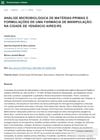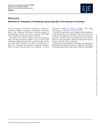Search
for
Sort by
Research
30-60 / 1000+ results
research The Substantiation of Plant Raw Materials Ratio and Determination of Raw Materials Technological Parameters in the Development of Complex Tincture for the Telogen Effluvium Treatment
The tincture made from nettle, sage, and horse chestnut in a 5:3:2 ratio is effective for treating telogen effluvium.

research Screening of Anti-Hair Loss Plant Raw Materials Based on Reverse Network Pharmacology and Experimental Validation
Certain plant extracts may help prevent hair loss and promote hair growth safely.

research Anti-Inflammatory Effects in LPS-Treated RAW 264.7 Cells and the Influences on Drug Metabolizing Enzyme Activities by the Traditional Herbal Formulas, Yongdamsagan-Tang and Paljung-San
The traditional herbal formulas Yongdamsagan-Tang and Paljung-san, along with the drug finasteride, can reduce inflammation and may work together without affecting each other's effectiveness against benign prostatic hyperplasia.

research Comparison of Three Different Lactic Acid Bacteria-Fermented Proteins on RAW 264.7 Osteoclast and MC3T3-E1 Osteoblast Differentiation
Fermented soy protein may help prevent bone loss by affecting bone cell activity.

research Study on Ajuga Reptans Extracts as Potential Cosmetic Raw Materials
Ajuga reptans extracts can improve skin hydration, elasticity, and reduce wrinkles.
research An Innovative Reverse-Phase High-Performance Liquid Chromatography Technique for Measuring Finasteride and Tadalafil in Raw Materials and Pharmaceutical Products with Stability Indication

research Sky Fruit Seed Crush: A Potential Source of Less Salt Curing of Raw Goatskin
Sky Fruit Seed Crush can preserve goatskin with less environmental impact than traditional methods.

research The Effects of Cheonggukjang Diet on the Scalp Hair of Middle-Aged Women Aged 40-60
Eating raw cheonggukjang improves scalp hair in middle-aged women.
research Determination of Protonation State in Molecular Salt of Minoxidil and 2,4-Dihydroxybenzoic Acid Through a Combined Experimental and Theoretical Study: Influence of Proton Transfer on Biological Activities
The MXD/24HA salt is more effective for hair growth than raw MXD.

research Substantiation of Technological Parameters of the Oil Extract Obtained from Urtica Dioica Roots Based on the Yield Determination of Phytosterols Using Capillary Gas Chromatography Method
The best way to extract oil from Urtica dioica roots is by using corn oil, a 1:5 ratio of raw material to extract, extracting for 6 hours, and using the maceration method.

research Improvement of Hair Loss by a Persimmon Leaf, Green Tea, and Sophora Fruit Extract Complex (BLH308)
BLH308, made from persimmon leaf, green tea, and sophora fruit, may help reduce hair loss by fighting oxidative stress and inflammation.

research Formulation and Evaluation of Herbal Hair Dyes from Tannin Producing Plants: A Substitute for Chemical Hair Dye
Herbal hair dyes from tannin-rich plants are effective and safer than synthetic dyes.

research Inhibition of 5α-Reductase of De Novo Generation of Short Antioxidant Peptides
DK peptides can reduce hair loss by inhibiting the 5α-reductase enzyme and have antioxidant effects.
research Multiactive Ingredients for Cosmetics. II
Multiactive ingredients like panthenol and B-vitamins improve hair and skin health.
research Effects of Some Medicinal Plant Extracts on Dermal Papilla Cells
Acanthus ebracteatus extract may help prevent hair loss.

research Microalgae, Tetraselmis Tetrathele Has Alopecia Prevention and Scalp Improvement
Tetrathelmis tetrathele extract may help prevent hair loss and improve scalp health.

research Unlocking Nature’s Secrets: Developing and Analyzing Herbal Hair Oil Formulation
Herbal hair oil made from herbs and coconut oil helps reduce dandruff and hair fall.
research Synchronous Fluorescence as a Green and Selective Method for the Simultaneous Determination of Finasteride and Tadalafil in Dosage Form and Spiked Human Plasma
A new green method accurately measures finasteride and tadalafil in drugs and plasma.

research Microbiological Analysis of Raw Materials and Formulations of a Compounding Pharmacy in Venâncio Aires, RS
The compounding pharmacy in Venâncio Aires generally follows good practices, with only the Paracetamol sample showing significant microbial growth.

research Experimental, Molecular Docking Investigations and Bioavailability Study on the Inclusion Complexes of Finasteride and Cyclodextrins
Cyclodextrins improve finasteride's solubility and bioavailability for hair loss treatment.

research Omics for Precious Rare Biosamples: Characterization of Ancient Human Hair by a Proteomic Approach
The study developed a method to analyze ancient hair proteins using very small samples.

research Comment on 'Androgenetic Alopecia Present in the Majority of Patients Hospitalized with COVID-19'
Hair loss link to COVID-19 severity likely due to other factors.

research Genome-Wide Gene Expression Dataset Used to Identify Potential Therapeutic Targets in Androgenetic Alopecia
Five molecular elements identified as potential future targets for hair loss therapy.

research Retraction of: Comparison of Finasteride Versus Flutamide in the Treatment of Hirsutism
The article was retracted due to data integrity issues.

research Preparation and Evaluation of Matruj SBA Hair Oil Containing Polyherbs for Arresting Hair Problems
The herbal hair oil effectively promotes hair growth, nourishes the scalp, and prevents dandruff.

research Ultrasonic-Assisted Extraction and In-Vitro Antioxidant Activity of Polysaccharide from Hibiscus Leaf
The study found an efficient method to extract antioxidants from Hibiscus leaves.

research Chemical Profiling and Quantitation of Bioactive Compounds in Platycladi Cacumen by UPLC-Q-TOF-MS/MS and UPLC-DAD
Researchers identified new compounds in Platycladi Cacumen and found variations in its flavonoid content, which could aid in its quality control.

research Development of a DNA-Analytical Method for the Identification of Animal Hair Fibers in Textiles
Researchers developed a new method to identify animal hair in textiles, which is effective for various fibers and more reliable than previous methods.

research Eupafolin Nanoparticles Protect HaCaT Keratinocytes from Particulate Matter-Induced Inflammation and Oxidative Stress
Eupafolin nanoparticles help protect skin cells from damage caused by air pollution.